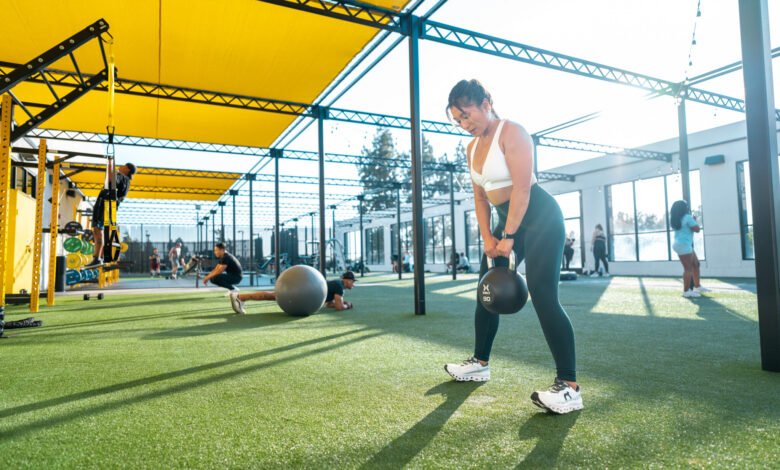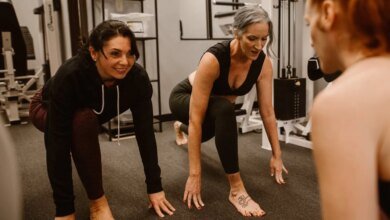Strength Training for Marathon Runners: Build Power and Prevent Injuries

Marathon training is all about logging miles, right? not quite. While running takes center stage during marathon training, strength training also plays an important role, serving as a powerful (and often overlooked) companion to your mileage goals.
Whether you’re a first-time marathon runner or an experienced runner chasing PRs, incorporating strength training into your weekly routine can help you run stronger, recover faster, and stay injury-free for longer. If you end up on a long run with sore hips or a sluggish walk, strength training may be the answer you’ve been missing.
Let’s explore how strength training for marathon runners can help you go the distance without burning out.
Why strength training matters for marathon runners
Strength training for marathon runners is not about gaining weight; It’s about building a durable and efficient engine. Research consistently shows that runners who incorporate strength training improve their running economy (how efficiently they use oxygen), stride mechanics, and endurance.
Here’s what it looks like in action:
- Better long-term placement, reducing wasted energy
- Your glutes and hamstrings are stronger to boost your stride and stabilize your knees
- A more flexible core helps you maintain shape when you get tired
- Fewer overuse injuries thanks to improved muscle balance and joint stability
Simply put: smart strength training helps you run smarter, not just harder.
Common myths about strength training for runners
Let’s clear the air around some myths that keep runners from embracing strength training:
Myth: Strength training causes you to bulk up
Building significant muscle mass requires a completely different approach than the one used in marathon preparation.
Low- to moderate-weight, high-repetition strength training (two to three times per week) improves strength and muscular endurance without increasing bulk.
Myth: Running is enough for exercise
Although running builds cardiovascular endurance, it does not fully strengthen all of the muscles and connective tissues you depend on.
Weak points, especially in the trunk, buttocks and hips, can lead to poor form and ultimately injury.
Myth: I don’t have time to run and strength train
Even two short strength sessions a week can make a big difference. If you’ve been avoiding strength training and have been sidelined by injury, now is a good time to do so truly Feel the cost of skipping it.
Best strength training exercises for runners
You don’t need to live in the gym or memorize complicated routines to see results. The key is to focus on functional compound movements that support your stride, balance, and joint stability.
The following exercises are suitable for runners and provide significant benefits with minimal equipment:
Squatting
To perform a squat, stand with your feet hip-width apart, then lower your hips back and down as if you were sitting in a chair. Keeping your chest up and core engaged, then press into your heels to return to standing. To combine weights, hold one dumbbell in each hand, keeping your arms at your sides.
This exercise targets:
- Ass
- The quads
- Hamstrings
- essence
Squats help strengthen your lower body and core, building the foundation you need to push off the ground efficiently with every step.
Deadlift
Hold one dumbbell in each hand. Next, with a flat back and a slight bend in your knees, hinge your hips to lower the weight toward the floor, keeping the dumbbells in front of your legs. Focus on maintaining good posture and squeeze your glutes as you stand back up to target:
- Hamstrings
- Ass
- Lower back
Deadlift exercises improve hip mechanics and strengthen the entire posterior chain, which plays a key role in stride strength and injury prevention.
Glute bridges or hip thrusts
Lie on your back with your knees bent and your feet flat on the floor. Drive through your heels to lift your hips toward the ceiling, squeezing your glutes at the top before lowering back down. If you want to incorporate weight, hold heavy dumbbells at your hips.
This movement helps activate and strengthen the glutes, which are often underutilized in runners and can lead to compensatory injuries if left weak.
Planks
Place your forearms on the floor and your body in a straight line from head to heels. Engage your core and buttocks, and hold this position for 30 to 60 seconds without letting your hips sag or sway.
Planks build deep core strength, supporting proper running posture and keeping your body solid, especially during long-distance fatigue.
Resistance band side steps
Place a resistance band around your thighs or ankles, bend slightly at the knees, and take controlled side steps while staying low in an athletic position.
This small but powerful movement targets your hip stabilizers, which play a big role in preventing knee collapse, IT band issues, and other common overuse injuries.
How to incorporate strength into your marathon training
Adding strength training to your marathon plan doesn’t mean sacrificing running. The key is to work smarter, not harder, and schedule your sessions strategically to support your ongoing goals.
Frequency: How often should runners strength train?
Consistency is key, but that doesn’t mean you need to do strength training every day. For most marathon runners, two to three sessions per week is the sweet spot. This allows you to build strength and promote good movement patterns without interfering with your running goals.
- Two full body sessions per week are sufficient during peak weeks.
- If you’re in a base-building phase or in the off-season, you can add a third day that focuses on core or single-leg stability.
This frequency gives your body the support it needs to power through long runs and recover efficiently, without adding unnecessary fatigue to your training load.
Timing: When to add strength work to your training week
Strategic timing makes a big difference when it comes to getting strong without getting tired. You’ll need to pair your strength work with less intense days and avoid lifting heavy before more demanding runs.
Try scheduling strength training to:
- Easy running days (run first, then lift) to put your hard efforts together
- Rest days, but keep the weights light and low volume to support recovery
- Cross-training days, especially if you combine weightlifting with yoga, stretching or movement
Avoid lifting heavy objects immediately before speed training, hill sessions, or long-distance running. You’ll benefit more from a run and strength session when your legs aren’t pre-fatigued.
Tapering: What to do in the final weeks before race day
In the final phase of marathon training, which is usually the last two or three weeks, your focus should shift to recovery, race preparation, and injury prevention. This means that your strength training routine should move into maintenance mode.
Here’s what it looks like:
- Reduce sets, reps and overall intensity
- Focus on movement and body weight movements that keep you limber and engaged without wearing you out
- Skip any new exercises or heavy lifting, which may cause pain or stress at the worst possible time
Think of this gradual period as a chance for your body to absorb all the hard work you’ve put in. By dialing back in and prioritizing active recovery, you’ll arrive at the start line feeling strong, grounded, and ready to run your best race.
Tips for safe and effective strength training
To get the most out of your sessions and stay injury-free, keep these principles in mind:
- Start light and focus on the model – Master the body weight versions of each exercise before adding resistance. Don’t rush this process, quality movement builds strength, not just heavy weight.
- Progress gradually – Increase weight, sets or repetitions over time. Here’s a good rule of thumb: If you can perform the final reps of a set with ease, you’re ready to level up.
- Listen to your body Pain is normal, but pain is not. Prioritize recovery, sleep, and hydration, especially during weeks when you’re covering long distances.
Also remember to prioritize your mobility work. Tight hips, ankles, and hamstrings can limit your range of motion. Incorporate dynamic warm-ups before your workouts and be sure to stretch or foam roll afterwards.
Special considerations for marathon runners
Every runner is different. Your strength plan should reflect your goals, training phase, and even your circadian rhythms, so keep these other factors in mind:
Period matters
Just as your running plan has phases (base, build, peak, and taper), so should your strength plan. At the beginning of training, focus on building strength. As race day approaches, turn to the pits.
Support your hormonal health
For women, hormonal fluctuations can affect energy, strength, and recovery. You may feel stronger during the first half of your cycle (follicular phase) and more tired before or during your period (luteal and menstrual phases).
Listen to your body and adjust accordingly, including lowering the weights, taking more rest, and switching to gentler movements when needed.
Nutrition supports strength
Force action creates micro-tears in your muscles that need fuel to repair. Make sure you get enough protein, carbohydrates, and hydration to support your running and lifting.
Lift Lab: Your Strength Friend
At Chuze Fitness, we understand that adding something new to your marathon routine can be a little intimidating. That’s why we created Lift Lab, a space dedicated to learning, growing, and getting stronger in a way that works for you You.
Whether you’re just starting out in strength training or want to improve your form before race day, Lift Lab is here to help you lift weights with confidence, stay injury-free, and feel strong with every move.
sources:
Cheswitch-Physics and Performance. Strength training for runners. https://www.chiswick-physio.co.uk/blog/strength-training-for-runners/
The world of runners. 5 signs of a weak butt and what to do about it https://www.runnersworld.com/training/a64687693/weak-glutes-signs-and-solutions/
WebMD. Cycle synchronization. https://www.webmd.com/women/cycle-syncing
 Reviewed by:
Reviewed by:
Annie is the Vice president of Fitness at Chuze Fitness and oversees the group fitness and team training departments. She has had over 25 years working in club management, personal training, group exercise and coach training. Annie lives with her husband and son in San Diego, California, and loves hot yoga, snowboarding, and all things wellness.
Don’t miss more hot News like this! Click here to discover the latest in Health and Fitness news!
2025-08-25 06:07:00




